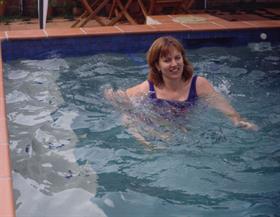Get a Grip on the Fundamentals of Being Healthy and Fit
- Self Paced Course
- Start any time
- Study from anywhere
LESSON STRUCTURE
There are 8 lessons in this course:
1. Introduction to Health and Fitness
2. Exercise Physiology
3. Exercise Principles and Cardiorespiratory Programming
4. Biomechanics and Risk
5. Fitness Program Design
6. Delivering a Fitness Program
7. Safety, Injury and General Wellbeing
8. Fitness Programs for Special Groups
Each lesson culminates in an assignment which is submitted to the school, marked by the school's tutors and returned to you with any relevant suggestions, comments, and if necessary, extra reading.

AIMS
- To explain the nature of the health and fitness industries.
- To explain the relationship between the body and health, fitness & exercise, with reference to physiological processes.
- To explain the relationship between the body and health, fitness & exercise, with respect to risk involved in exercise.
- To evaluate body movements during different exercises.
- To design fitness programs, which are both safe and effective, to fulfill specified requirements of an individual.
- To deliver a fitness program to a small group of clients.
- To manage the wellbeing of participants in a fitness program, including safety and injury.
- To design fitness programs, which are both safe and effective, catering to needs of special populations (including weight control programs and programs for handicapped/disabled persons).
BASIC COMPONENTS OF PHYSICAL FITNESS
Strength
Most people think that to be strong is to be fit. This may be partly true, for strength is only one element of strength. It can be defined as “the capacity of a muscle to exert maximal force against a resistance”. Strength can be increased by certain kinds of exercise. Strength training (exercising to develop strength) will result in some enlargement of muscle fibres and a relative increase in the body’s ability to apply force. The most efficient way to rapidly gain strength is through properly conducted weight resistance programs, which require exercising with barbells. Incorrect use of barbells or other weight equipment, however, can cause damage, and if the person is too young and the muscles are not fully developed, may hinder growth.
Muscular Endurance.
Endurance is the capacity of a muscle to exert force repeatedly over a period of time'. ‘Muscular endurance refers to the ability to hold a muscle contracted for a period of time.' Endurance is not the same as strength, though it may improve with improved strength.
Your ability to do sit ups or pull ups is a measure of your muscular endurance. The distance which you can jog without stopping to walk is a measure of your muscular endurance. By doing these types of exercises and gradually increasing the number of repetitions, a person can increase their muscular endurance.
Flexibility
Flexibility is the ability to move a muscle through its full normal range of movement. It may or may not be associated with strength or endurance, but is as important to one’s ability to function well as either of these. Flexibility essentially refers the mobility of your joints, and the capacity of your long muscles to stretch. Some measures of flexibility are the ability to touch one’s toes without bending at the knees, or to bend backwards. The most effective exercises for increasing flexibility are those that stretch muscles to their full extent (but not beyond their limit, otherwise muscles can be damaged).
Motor Skill Performance
This refers to the ability of the nerves to receive and provide impulses which result in smooth, coordinated muscular movement. Good motor skill performance is evident in your ability to dodge, control balance, and react and move quickly. Motor skill exercises include such things as the vertical jump, agility runs, squat thrusts, etc.
Cardiorespiratory Endurance
The capacity of your heart, blood vessels and lungs to deliver nutrients and oxygen throughout the body is called your cardiorespiratory endurance. It is important because vigorous exercise increases the cells’ need for oxygen. To meet this need, you must be able to easily breathe in more oxygen, and your heart must fit enough to pump more through the body. Vigorous exercise is the best way to increase cardiorespiratory endurance. However, here again, caution is required, since too much vigorous exercise too soon can be dangerous.